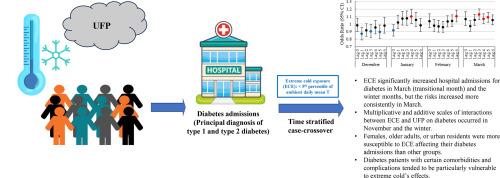Unseasonal extreme cold weather, ultrafine particles, and diabetes hospitalizations: an unexpected time window for intervention
IF 2.7
引用次数: 0
Abstract
Background
Although the associations between ambient heat and diabetes have been assessed, the odds of ambient extreme cold exposure (ECE) or ultrafine particles (UFP) on diabetes admissions are understudied.
Objectives
We assessed the impacts of ECE on diabetes hospitalization and evaluated the modifications of demographics, comorbidities, and UFP on ECEdiabetes associations.
Methods
A time-stratified case-crossover study was conducted by using mandatory New York State (NYS) admission data (principal diagnosis, 2013–2020) and temperature and simulated UPF data from NYS Mesonet and a global chemistry transport model, respectively. We defined ECE as <5th percentile of daily mean temperature and UFP-high as >50th percentile of the daily mean UFP. After adjusting for air pollutants, humidity, and holidays, we conducted conditional logistic regressions to investigate ECE-diabetes associations, additive and multiplicative interactions between UFP, demographics/comorbidities, and ECE.
Results
Diabetes admissions associated with ECE were significantly elevated in winter months (ranges of odds ratios (ORs): 1.099–1.104, P < 0.05 in January and February) but the associations increased more consistently across multiple lag days in March (ranges of ORs: 1.068–1.129, P < 0.05). ECE-diabetes associations were significant among patients with peripheral circulatory complications and hyperglycemia compared to those without these complications. UFP-diabetes associations were significant in November (OR: 1.052, 95 % confidence interval (CI): 1.012–1.093) and December (OR: 1.045, 95 % CI: 1.003–1.088). Additionally, ECE-UFP interactions on diabetes were significant at both additive (95 % CI >0 for the attributable proportion to interactions and relative excess risk index) and multiplicative (P < 0.05 for product terms) scales. Furthermore, females, older adults, urban residents, and patients with multiple comorbidities were more vulnerable to ECE than other groups.
Conclusions
ECE-diabetes associations were significant in winter months, but the increased associations occurred more persistently in March. While synergistic and additive interactions between ECE and UFP on diabetes were found, ECE-diabetes ssociations were also modified by demographics and comorbidities.

非季节性极端寒冷天气、超细颗粒和糖尿病住院:一个意想不到的干预时间窗口
虽然环境热与糖尿病之间的关系已经被评估,但环境极冷暴露(ECE)或超细颗粒(UFP)对糖尿病入院的可能性尚未得到充分研究。目的:我们评估了ECE对糖尿病住院的影响,并评估了人口统计学、合并症和UFP对ECE糖尿病关联的影响。方法采用纽约州(NYS)强制性入院数据(主要诊断,2013-2020年)、NYS Mesonet和全球化学输运模型的温度和模拟UPF数据,分别进行时间分层病例交叉研究。我们将ECE定义为日平均温度的第5个百分位数,将UFP-high定义为日平均UFP的第50个百分位数。在对空气污染物、湿度和节假日进行调整后,我们进行了条件logistic回归来调查ECE与糖尿病的关联、UFP、人口统计学/合并症和ECE之间的相加和相乘的相互作用。结果与ECE相关的糖尿病入院率在冬季显著升高(优势比范围:1.099-1.104,P <;在1月和2月为0.05),但在3月的多个滞后日中,相关性更加一致地增加(or范围:1.068 ~ 1.129,P <;0.05)。与没有这些并发症的患者相比,有外周循环并发症和高血糖的患者与ece -糖尿病的相关性显著。11月(OR: 1.052, 95%可信区间(CI): 1.012-1.093)和12月(OR: 1.045, 95% CI: 1.003-1.088) ufp -糖尿病相关性显著。此外,ECE-UFP对糖尿病的相互作用在相加性(相互作用归因比例和相对超额风险指数95% CI >;0)和乘法(P <;0.05为产品条款)的尺度。此外,女性、老年人、城市居民和有多种合并症的患者比其他人群更容易发生ECE。结论sce -糖尿病相关性在冬季显著,但在3月份增加更为持久。虽然发现了ECE和UFP对糖尿病的协同作用和加性相互作用,但ECE与糖尿病的关联也受到人口统计学和合并症的影响。
本文章由计算机程序翻译,如有差异,请以英文原文为准。
求助全文
约1分钟内获得全文
求助全文
来源期刊

Hygiene and environmental health advances
Environmental Science (General)
CiteScore
1.10
自引率
0.00%
发文量
0
审稿时长
38 days
 求助内容:
求助内容: 应助结果提醒方式:
应助结果提醒方式:


